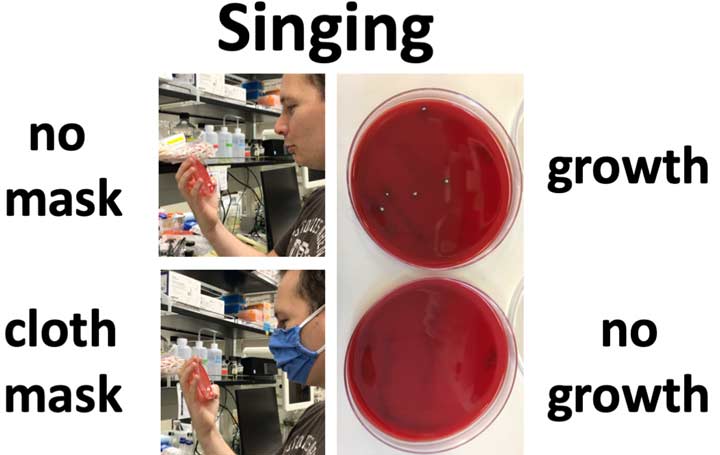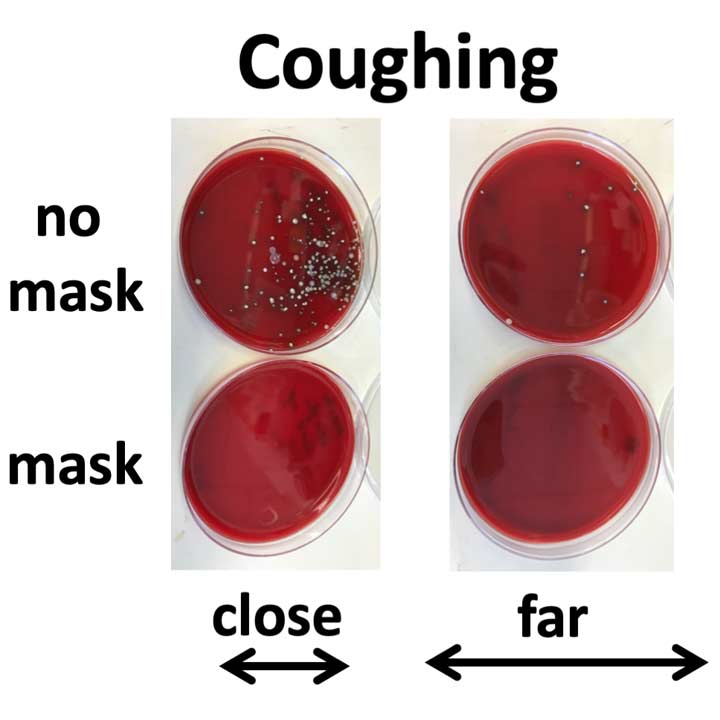-
-
Written by: Katelyn Lott
-
Even with the current Alabama mask mandate and months of counsel from medical professionals, there are many people that still refuse to wear a mask. In an effort to show the effectiveness of mask wearing in preventing the spread of infectious diseases such as the ongoing COVID-19 pandemic, Payton Walker from WAFF 48 News joined our own Dr. Tanya Sysoeva for an experiment. In this experiment Ms. Walker and Dr. Sysoeva each talked, sang, and coughed for 5-10 seconds in front of their own individual sets of TSA Blood Agar plates. Both a close-range distance of approximately 6 inches away from the plate and a further distance of approximately 16 inches away from the plate were utilized. Three different types of masks (cloth, surgical, and N95 masks) were tested, as well as talking, singing, and coughing without a mask. The carefully labeled blood agar plates were incubated for a couple of days and then the results were checked.

Experiment setup showing that Blood agar plates are used to capture respiratory droplets carrying germs from our oral and nose cavities through the air when we breathe, talk, sign, sneeze, and cough.
Image courtesy of Tanya Sysoeva
Interestingly, there was no growth whatsoever seen on any of the “masked” plates for either test participant. There was no visible difference in results between each mask type. However, visible bacterial growth was seen for one of the “unmasked” plates contributed by Ms. Walker, as well as the “unmasked” plates contributed by Dr. Sysoeva. There was a marked difference in number and type of bacterial colonies between both sets of “unmasked” plates, demonstrating the different types of bacteria each person might contribute and showing the effect of length of exposure time, as well as giving an idea of how much the individual might naturally project their speech. The effect of distance in determining bacterial or viral amount was also seen, as the “unmasked” plates that were inoculated from the closer, 6 inch distance showed a noticeably higher concentration of bacterial colonies than was seen on the plate that had been inoculated from approximately 16 inches away; conclusions about the efficacy of social distancing practices in preventing viral spread could potentially be drawn from this observation.

Experiment showing protective effect of masking and distancing to prevent bacterial spread via cough.
Image courtesy of Tanya Sysoeva
Although this experiment measures bacterial transmission for simplicity’s sake, viral particles are able to exit the human body via the same respiratory droplets and aerosolization as are bacteria, showing this to be an accurate visualization for the spread of COVID-19. Given the clear differences seen between the blood agar plates inoculated with and without wearing a mask, it can be inferred that the simple act of mask wearing is indeed effective in curbing the spread of potentially infected respiratory droplets and thus the spread of COVID-19.
More details on this experiment can be found at https://www.waff.com/2020/07/16/experiment-shows-how-mask-can-prevent-bacteria-spread/.
 Academics Sub-Menu
Academics Sub-Menu